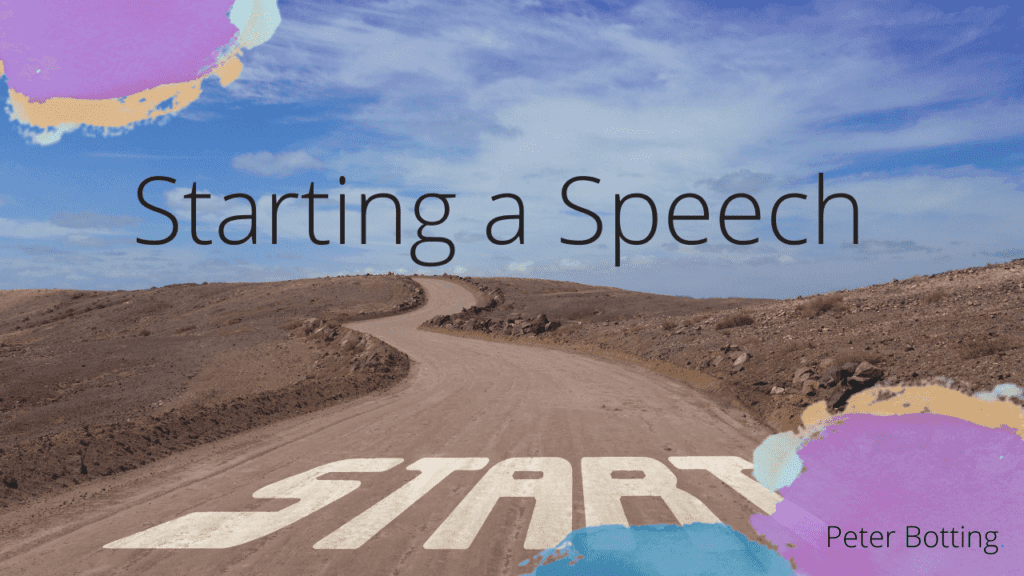There are lots of ways to start a speech. Most are crap. Facts are facts – how many speeches have you heard, and how many were good?
Starting a speech badly is a massive mistake. It doesn’t matter how good the main body of your speech is, the essence of your argument, or the quality of your examples; it doesn’t matter how well you craft, articulate, or deliver it. It doesn’t matter how worthy your cause is, it doesn’t matter how strong your conclusion is, it doesn’t matter how explicit your call to action is. It doesn’t matter how you end your speech if you start it badly. They’re not listening.
Starting your speech well grabs people’s attention – you get their eyes off their phones, you stop them talking, and you get their attention. A good start to your speech makes them understand that the speech is relevant to them, that something is coming that is worth listening to, something is broken that is fixable, and that there is space for action that they can contribute to, participate in, or do on their own.
However, if you start a speech badly, they WILL carry on talking or checking their apps, emails, or messages on their phones – their attention is distracted or not even shared with you.
If you don’t get their attention, you don’t get their awareness, and you definitely don’t get a chance to convince them about anything, let alone move them to action.
Of course, a good start is not enough. You also need a strong argument, a narrative, a worthy cause, and a concise call to action. But without a strong start to your speech, the rest of your efforts will likely be wasted, or their impact will be watered down.
Whichever option you choose to start your speech, you need to start strong. Please don’t clear your throat with platitudes and cliches or wordy, boring BS nonsense like: “Mr Chairman, I’m delighted to be here today on the occasion of blah blah blah blah blah blah blah blah blah blah blah blah….” it’s all just shit that says nothing apart from … “Your attention, Ladies and Gentlemen, is not yet required – no substance or anything of value is being said at the moment, please continue as you were!”
Ten ways to start a speech well
Here are ten well-known ways to start a speech that, when done well, will help your speech be better (or at least less dull) and maybe even grab your audience’s attention.
- Begin with a strong opening statement that grabs your listener’s attention. This should get their eyes off their phone, get their heads up, and set the tone for the speech. “Ladies and Gentlemen, right now, within a 5-minute drive of this building, in this country, there are victims of Human Trafficking living and working…”.
- Ask a question to engage the audience and make them think. Question: “Have you ever stopped to think about how your life would be different if you couldn’t read… ?”
- Use a quote or a statistic to establish credibility and authority on the topic. “Einstein said, ‘Education is not the learning of facts, but the training of the mind to think.’ Z% of graduates from Y university said they were studying to get a job and not to think…”
- Deploy Humor: Use humour to break the ice and put the audience at ease. “Good Afternoon, Ladies and Gentlemen. Good Morning Dear Students….”
- Paint a vivid picture or create a mental scene to help the audience visualize the topic and make it more engaging. “Close your eyes and imagine a world where… Imagine….. Think of … free ice-cream cones… “. (I bet you have that image in your head now…).
- Use a hook or a teaser to trigger the audience’s curiosity and make them want to hear more. “What if I told you that maths, words, and clean water could be the key to solving most of the world’s issues?”
- Use a personal story or anecdote to connect with the audience and make the topic relatable. “When I was a child, we lived in a country in the middle of a civil war…”
- Use rhetorical devices such as anaphora, antithesis, and chiasmus to create a memorable and impactful opening. “We shall fight in the schools. We shall fight in the colleges. We shall fight in the universities… we shall never stop educating…”
- Use a call to action to inspire and motivate the audience to take action. “Surely we can make sure that every kid leaves school able to read, write and cook…”
- Use a strong statement or thesis to clearly state the purpose of the speech and focus the audience’s attention. “Investing in education is not just morally right, but it’s also a smart, national economic decision.”
How to not start a speech
“Mr Chairman, Ladies and Gentlemen… ”
This type of incredibly common throat-clearing, where you speak words but say nothing is a waste of your time and your audience’s. Stop doing it. It won’t get their faces away from the glow of their phones.
Get on the stage nd pause. Then start strong with a story or one of the tips listed above.

